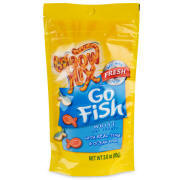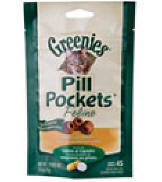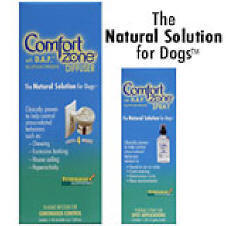__ 1) Instruct
pet
parents to bring
in all pets HUNGRY
to help
the pet perceive your
location as the
"Cookie
Place" not
a
dungeon of horrors. 
Ideally,
fast the pet for 24 hours if
no medical conditions make
this inappropriate. At a
minimum,
skip the meal prior to
the visit.
__ 2)
Ask the
pet
parent to
bring in
a zip lock bag
filled
with
pet's
favorite treats to
distract the pet from any
injection or other procedure
(e.g. ear clean, blood draw,
nail trim, etc).

 Food
treats help the pet form
a positive impression of
your location. (Click on
image above for easy
online ordering.)
Food
treats help the pet form
a positive impression of
your location. (Click on
image above for easy
online ordering.)
__ 3)
On the
phone, ask pet parents to
bring in
the pet's
fecal
sample, "just
in case the
DVM
needs it."
Explain that
bringing
in a sample prevents
the
negative experience
of a
fecal sample collection.
Collect in a freezer
type ziplock baggie. Add
a drop of moisture and
keep in the refrigerator
overnight.
 __ 4)
Show (teach) the pet parent to give
small treats - the size of a
raisin or Cheerio. Bring in
the pet's favorite toys.
Interactive play is a great
way to lower pet stress and
create a positive
association with your
location.
__ 4)
Show (teach) the pet parent to give
small treats - the size of a
raisin or Cheerio. Bring in
the pet's favorite toys.
Interactive play is a great
way to lower pet stress and
create a positive
association with your
location.
__ 5) Use
food and toys to put the
pet's mind on something
positive during injections.
Add
comfort - pheromones
__ Instruct clients to spray Feliway (cats) or put on DAP
collar (dogs) prior to
putting the pet in the
kennel for the veterinary
visit.

 Feliway
and DAP are natural
pheromones that have a
Feliway
and DAP are natural
pheromones that have a calming affect.
Recommend pet parents
"kennel train" pets and
take car rides that
result in a positive
experience. Use treats
in kennels. Skip the
meal prior to a car ride
and feed immediately
upon return.
calming affect.
Recommend pet parents
"kennel train" pets and
take car rides that
result in a positive
experience. Use treats
in kennels. Skip the
meal prior to a car ride
and feed immediately
upon return.
Emotional
pain relief
__
Use the
kindest (smallest) needle
possible. Less painful = 25ga. More
speed = 22ga.
__ Use
"Distraction
Techniques" to help prevent a
negative
pet experience.Try the following methods.
Change the method for each
injection or minor
treatment.
-
Put food
treats on the exam table.
Try a
line of Cheez Whiz.
-
Slip
and slide the pet
toward the edge of
the table - give the
injection and slide
the pet back to the
table center.
-
Spin
the
pet on the table.
-
Use a
hug/squeeze
done by your
assistant or the pet
parent,
-
Use a
towel over
the head
(hooding).
-
Pull
a string to engage a
kitten or cat.
-
Put
Farmer John's
liverwurst ( or
peanut butter) on a
tongue depressor.
TIP: For
puppies that are anxious....
__ 1) Hold next to your body and
talk to the pet parent about
preventive health or
behavior, allowing the puppy
to relax.
__ 2) Hold the puppy
tightly against your hip but
completely relax your body
tone, take a deep breath and
let out a sigh. When the
puppy begins to relax, you
relax your hold, slowly and
progressively.
Physical
pain relief
One of
the goals of a
pet centered practice
is to protect pets from
fearful or painful
experiences in the
veterinary hospital. A
pet-centered
practice
offers pet parents the option of
sedation to lower both
physical and emotional pain
associated with minor medical
treatments.
Much like
human dentists now offer
medicines to help patients
relax, the veterinary
professional understands the
pet parent's sensitivity to
a pet's discomfort. The pet
parent will hesitate to
bring in a pet who shows
fear.
__1)
"Happy
Gas." For cats or small
dogs up to 15 lbs, i.e.
small enough to fit into the
anesthetic chamber. This is
very safe, and can usually
be done while the owner
waits. The pet falls asleep
and remembers nothing.
"__
2) "Happy
Juice" For dogs over 15
lbs. This can be
reversed while the owner
waits in some cases, OR the
pet may stay for the day.
If not reversed the owner
should be aware the dog will
be sleepy for 24 hours
(which may be desirable).
The pet has to have a
physical, with no scleral
icterus or cardiac disease.
The protocol is to give
Xylazine SQ at approximately
0.75cc/20 lbs, plus an equal
amt. of Atropine in the same
syringe, with a "kind
needle" and a distraction
technique.
Become
the "Puppy Place!"
__ 1)
Enroll
every puppy in puppy
parties
(off leash play). Early
socialization (prior to 4
months of age) builds
emotional confidence and
makes
your location a "happy
place."
__ 2) Offer
early
puppy daycare
for more positive
socialization through play.
Puppies need to start prior
to four months of age. Group
puppies in runs by age and
size beginning at 8 9 weeks
of age.
__3)
Recommend
three
times/week for
puppies up
to 5 months, then weekly
until two years old to maintain their canine
social skills.